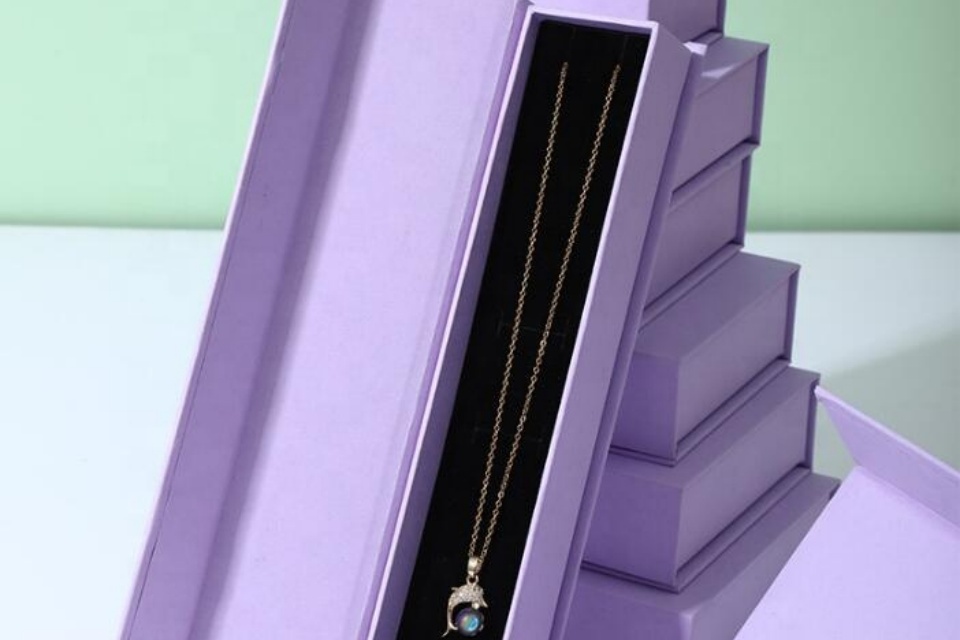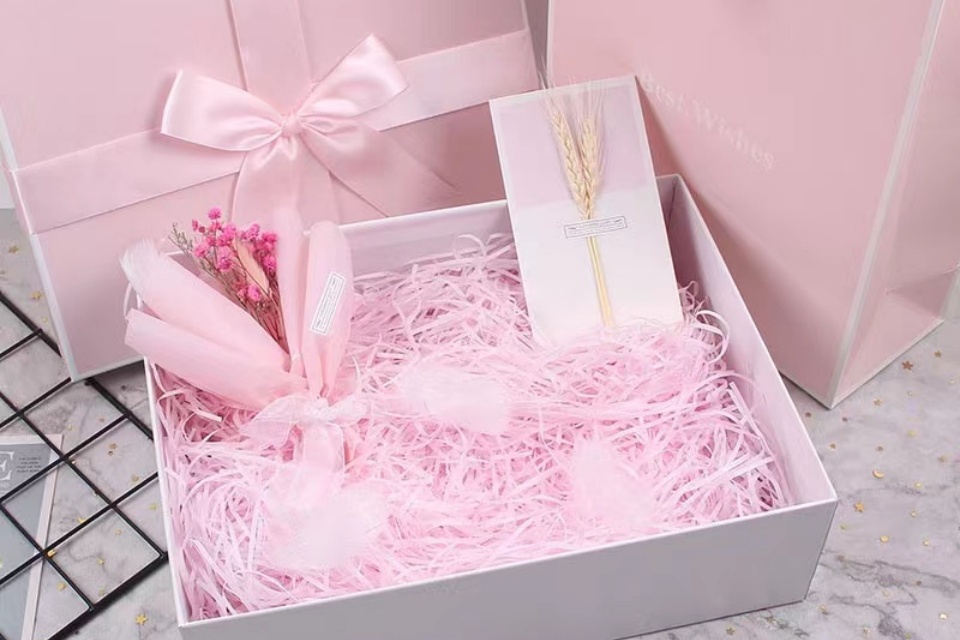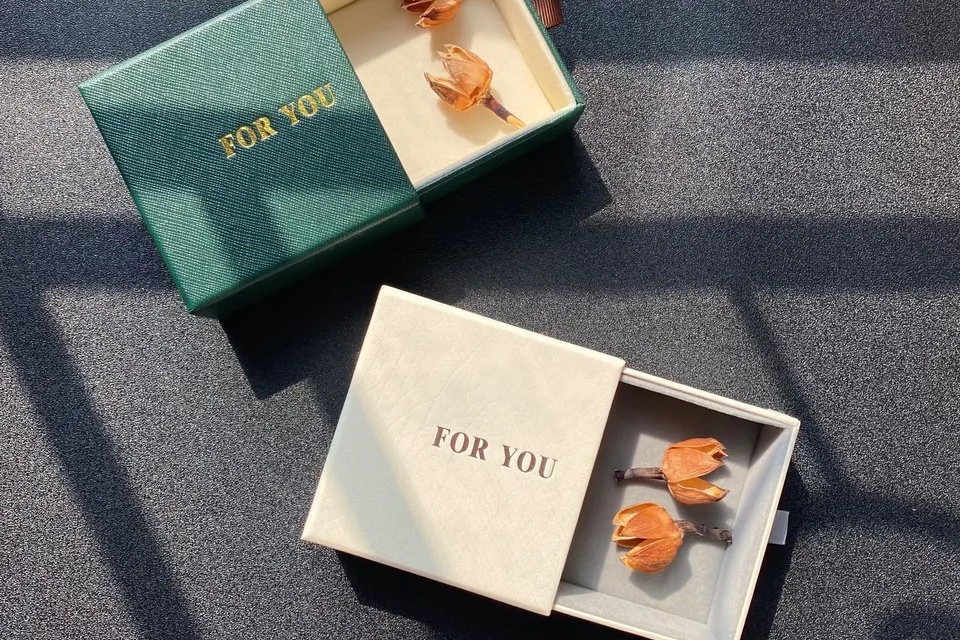Lastest News
Packaging Small Vs. Large Jewelry Items
Packaging Small Vs. Large Jewelry Items
Summary
Jewelry packaging encompasses the materials and designs utilized to protect and present jewelry items during transport and sale. This critical aspect of the jewelry industry significantly enhances customer experience and brand identity, with various packaging solutions tailored to both small and large jewelry items. As consumer preferences evolve, there has been a notable shift towards sustainable and eco-friendly packaging options, prompting brands to adopt innovative materials that minimize environmental impact while maintaining aesthetic appeal.
The packaging of small jewelry items—such as rings, earrings, and delicate necklaces-requires particular attention to detail, balancing protection and presentation. Effective packaging solutions, including compact boxes, velvet pouches, and anti-oxidation bags, ensure the items remain secure and untarnished during transportation. Additionally, the choice of packaging can enhance the unboxing experience, catering to different consumer demographics, from luxury buyers to eco-conscious shoppers. Conversely, large jewelry items, like statement necklaces or intricate bracelets, demand specialized packaging to prevent damage, requiring sturdy materials and adequate space to avoid tangling or crowding.
Notably, the packaging strategies employed by leading brands such as Tiffany & Co., Mejuri, and Royal Way illustrate the importance of aligning packaging with brand values and consumer expectations. These companies have successfully integrated sustainable practices into their packaging designs, utilizing recycled materials and eco-friendly alternatives to meet the growing demand for environmentally conscious products. This alignment not only attracts a loyal customer base but also reflects a commitment to responsible sourcing and environmental stewardship.
Despite the clear benefits of sustainable packaging, brands must also navigate challenges related to cost, quality, and functionality. Striking a balance between protecting the jewelry, maintaining aesthetic appeal, and managing expenses remains a critical consideration for businesses in the jewelry packaging sector. As the industry continues to evolve, the focus on sustainability and customer experience will play an increasingly vital role in shaping packaging choices for both small and large jewelry items.
Types of Jewelry Packaging
Jewelry packaging is essential for protecting items during transport and enhancing the customer experience. Various materials and designs are used in jewelry packaging, catering to different types of jewelry and customer preferences.
Eco-Friendly Options
Sustainability has become a significant consideration in the jewelry packaging industry. Eco-friendly materials such as linen pouches, recycled cardboard, and biodegradable plastics are increasingly popular. Linen pouches, for example, provide a luxurious, reusable option that can be personalized with a brand's logo, offering both protection and aesthetic appeal. Similarly, packaging made from recycled plastics and plant-based materials, like bioplastics, helps reduce environmental impact, although these may come at a higher cost due to their sustainable nature.
Paper-Based Packaging
Paper-based options are versatile and cost-effective. Commonly used materials include cardboard, specialty papers like embossed or kraft paper, and corrugated options. Cardboard is particularly favored for its lightweight and recyclable qualities, while kraft paper imparts a rustic, eco-friendly feel. Specialty papers can elevate a brand's presence through distinctive textures and finishes, making them an excellent choice for standout packaging.
Metal Packaging
Metal packaging, such as tin and aluminum, is renowned for its durability and corrosion resistance. This type of packaging is commonly used for high-end jewelry, providing a luxurious look while protecting the contents from moisture and oxidation damage. Brands like Pandora utilize tin for limited-edition packaging, ensuring both aesthetics and functionality are met.
Fabric and Specialty Materials
Fabric-based packaging options, including velvet and jute, offer a tactile and luxurious experience. These materials are often employed for high-end jewelry to create a sense of elegance and sophistication. Other innovative options include plastic, glass, and acrylic display boxes, which allow customers to see the jewelry while providing protection.
Custom Packaging Solutions
Customization in jewelry packaging can enhance brand identity and improve customer satisfaction. Options such as monogrammed boxes, colorful decorative papers, and personalized messages can create a unique unboxing experience. Moreover, protective features like foam inserts and molded compartments can minimize movement and safeguard fragile pieces during transport.
Considerations for Packaging Small Jewelry Items
When packaging small jewelry items, several key factors must be considered to ensure both protection and presentation. Small jewelry pieces, such as earrings, rings, and delicate necklaces, require specific packaging solutions to enhance their appeal and safeguard them during transit.
Types of Small Jewelry Packaging
Small jewelry packaging options typically range from compact boxes to pouches. These packaging solutions are ideal for securing and showcasing a limited collection of jewelry pieces. For instance, small sustainable jewelry boxes with dimensions of 5 to 8 inches can hold 5 to 10 items, making them perfect for frequent travelers or casual wearers who value portability. Velvet pouches, eco-friendly boxes, and custom-branded wrapping paper are also popular choices, as they not only protect the items but also enhance the unboxing experience with added aesthetic value.
Protective Measures
To maintain the integrity of small jewelry items, anti-oxidation bags are commonly used. These bags protect jewelry from air, moisture, and dust, ensuring that pieces remain untarnished during transportation and storage. Various types of anti-oxidation bags, such as OPP self-adhesive bags and PVC self-sealing bags, cater to different jewelry materials and preferences, each offering unique attributes regarding transparency, durability, and environmental impact.
Consideration of Size and Fit
Choosing the right size for packaging is crucial, particularly for smaller items. It's important to measure the jewelry accurately and select a box or pouch that not only fits snugly but also allows for adequate protection without excessive movement. Internal dimensions must be considered to ensure the jewelry fits securely, especially for tightly fitted pieces like rings. Additionally, the packaging should feature soft inner linings, such as felt or velvet, to protect the jewelry's surface while keeping the overall dimensions manageable.
Customer Experience
The overall customer experience is enhanced by thoughtful packaging choices that reflect the brand's image and cater to the target audience. Tailoring the packaging to meet customer preferences—whether for luxury buyers, eco-conscious consumers, or budget-savvy shoppers—can significantly impact customer satisfaction and brand loyalty. Using unique designs and high-quality materials can further elevate the perceived value of the jewelry, making the packaging an integral part of the product itself.
By addressing these considerations, jewelry businesses can effectively package small items, ensuring they arrive safely while leaving a lasting impression on customers.
Considerations for Packaging Large Jewelry Items
When it comes to packaging large jewelry items, several key considerations must be taken into account to ensure both the safety and presentation of the pieces.
Functionality and Protection
First and foremost, the functionality of the packaging is crucial. Large jewelry items, such as statement necklaces or intricate bracelets, often require specialized packaging materials to provide adequate protection during transit. The choice of packaging material should not only align with the size and fragility of the jewelry but also offer sufficient insulation against impacts. Using sturdy materials, such as solid wood boxes or hard cases, can help mitigate damage during shipping and ensure that the items arrive at their destination in pristine condition.
Size and Space Management
The size of the packaging is another critical factor. It is essential to provide ample space for large pieces to avoid crowding or tangling. For instance, flat, long boxes are suitable for necklaces to keep the chains laid flat and prevent kinks, while square or rectangular boxes with padding are ideal for bracelets to prevent them from rubbing against each other. Additionally, custom inserts or compartments can help secure the items within the packaging, minimizing movement during transit and reducing the risk of damage.
Environmental Considerations
In today's market, many consumers prioritize sustainable packaging options. Therefore, it is important to consider environmentally friendly materials and practices when designing packaging for large jewelry items. Using recycled materials or eco-friendly alternatives can enhance the brand's image and appeal to environmentally conscious customers, all while still ensuring that the jewelry is protected and well-presented.
Cost vs. Quality
Lastly, while it is vital to invest in high-quality packaging for large jewelry items, it is equally important to consider packaging costs. Finding a balance between adequate protection and affordability is key. Brands should strive to use enough packaging to safeguard their products without incurring excessive costs that could deter potential customers. Careful planning and selection of materials can help achieve this balance, ensuring both the jewelry and the packaging reflect the brand's quality and values.
Environmental Impact of Jewelry Packaging
Jewelry packaging has a significant environmental impact, particularly due to traditional materials often employed in the industry. Conventional packaging, characterized by plastic, foam, and other synthetic substances, contributes to pollution and the depletion of natural resources. As awareness of these issues grows, the jewelry industry is increasingly compelled to rethink its packaging strategies to embrace sustainability.
The Shift Towards Sustainable Practices
In recent years, sustainability has become a focal point for consumers, with many prioritizing brands that exhibit environmental consciousness. Studies indicate that approximately 66% of customers consider a brand's stance on sustainability when making purchasing decisions. This shift in consumer preferences is pushing brands to adopt eco-friendly packaging materials, such as recycled paper, biodegradable plastics, and other natural resources. Sustainable materials not only help reduce waste but also reflect a commitment to responsible sourcing and environmental stewardship.
Benefits of Eco-Friendly Packaging
The transition to sustainable packaging is not merely a trend but a necessity for mitigating environmental impacts. Eco-friendly packaging materials, including biodegradable plastics and recycled paper, are designed to minimize waste throughout their lifecycle—from raw material procurement to end-of-life reuse or recycling. These materials can significantly reduce carbon emissions and resource consumption associated with traditional packaging methods. Moreover, lightweight packaging options decrease shipping costs and lower pollution generated during transportation.
Consumer Awareness and Brand Transparency
As consumers become more informed about the environmental impacts of their purchases, the demand for transparency in packaging choices has increased. Brands that disclose their sustainable practices and utilize certifications, such as FSC (Forest Stewardship Council), can build trust and enhance their appeal among eco-conscious buyers. This transparency not only attracts customers but also fosters brand loyalty as consumers appreciate brands that align with their values regarding sustainability.
Case Studies of Leading Brands
Royal Way: Embodying Brand Identity through Packaging
Royal Way, a small jewellery business, exemplifies how effective packaging can reflect a brand's identity. Their packaging features boxes in various sizes, each embroidered with unique finishes that enhance the luxurious feel of the brand. The elegant color scheme and flowery design reinforce the royal aesthetic, showcasing the importance of consistent branding throughout their sales strategies and marketing efforts.
Mejuri: Sustainable and Reusable Solutions
Mejuri has taken a progressive approach to packaging by using refillable cloth pouches made from organic cotton. These pouches are travel-sized and promote waste reduction. Additionally, Mejuri ships products in biodegradable mailing bags, further emphasizing their commitment to sustainability and eco-friendly practices. This strategy not only appeals to environmentally conscious consumers but also enhances the brand's overall appeal.
Tiffany & Co.: Tradition Meets Sustainability
Tiffany & Co. continues to evolve its packaging strategy by incorporating recycled materials into its iconic blue boxes. All paper components are FSC-certified, demonstrating their dedication to responsible sourcing. This commitment to sustainable practices not only preserves their heritage but also aligns with modern consumer values, who increasingly prioritize eco-friendly options.
Bario Neal: Artistic and Unique Packaging
Bario Neal employs recycled wood for its packaging, which minimizes waste while providing a unique and artistic presentation of their jewellery. This thoughtful design approach appeals to eco-conscious consumers who appreciate brands that prioritize sustainability. By using distinctive materials, Bario Neal not only protects their products but also enhances their market presence through innovative packaging solutions.
The Importance of Strategic Partnerships
For successful packaging strategies, collaboration with the right suppliers is crucial. Brands like Royal Way and Mejuri benefit from having access to sustainable packaging options that offer quality, reasonable pricing, and stability in supply. As more standardized dimensions become available, smaller brands are also able to present themselves as professional and eco-friendly without the financial burden of bespoke designs.
These case studies illustrate that effective packaging not only serves to protect products but also plays a significant role in expressing a brand's identity, values, and commitment to sustainability.
Categories
Latest News
Contact Us
Contact: Aaron Lee
Phone: +8613570866244
Tel: +8675529490260
Add: Li Songlang 2nd Industrial Zone,No.18,FengTang Rd,Guangming New District


